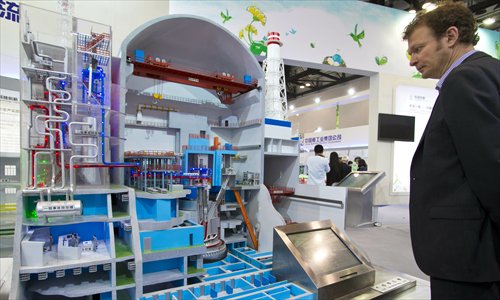State nuclear firms merge
Intended to boost exports of nuclear technologies

A visitor looks at a nuclear reactor model in a nuclear industry exhibition in Beijing. File photo: CFP

The newly announced merger of China Power Investment Corp (CPIC) and State Nuclear Power Technology Corp (SNPTC) will help the country's nuclear industry grow while boosting exports of nuclear technologies, analysts told the Global Times over the weekend.
Chinese major nuclear power operator CPIC and the general contractor of reactor units SNPTC are combining into a new entity, which was approved by the State Council, China's cabinet, according to the announcement published on the two companies' websites Friday.
The new nuclear power firm will be chaired by Wang Binghua, former chairman of SNPTC, the announcements stated.
SNPTC has been seeking to merge with CPIC since 2014, according to Xinhua News Agency, citing Guo Hongbo, the spokesperson from SNPTC. The company submitted the merger plan to the State-owned Assets Supervision and Administration Commission (SASAC) for approval in July 2014.
During a nuclear energy conference in South Africa in March, Wang noted that the total assets of the newly merged company were expected to exceed 700 billion yuan ($112.7 billion) and its annual revenue would likely be over 200 billion yuan, the China News Service reported in March.
The total assets of CPIC were $111.39 billion and the company's annual revenue recorded $29.79 billion by the end of 2014, according to CPIC's website.
CPIC, along with China National Nuclear Corporation (CNNC) and China General Nuclear Power Corporation (CGN), are three State-owned corporations approved by the National Nuclear Safety Administration (NNSA) to operate nuclear power plants, according to a report about Chinese nuclear power published by World Nuclear Association (WNA) in May. CPIC aims to achieve 14 gigawatts in operational capacity by 2020, with 10 gigawatts under construction and nine sites with 40 units, according to the report.
The tie-up between CPIC and SNPTC will change the landscape of the country's nuclear industry, noted Li Ying, analyst from State Grid Energy Research Institute.
"CPIC will help SNPTC get the required licenses to operate nuclear plants while SNPTC provides R&D," Li told the Global Times Sunday.
The combined company will also be considered a major rival to CNNC, said an employee from CNNC who refused to be named.
He noted that if AP1000 nuclear reactor units implemented in Sanmen county, in East China's Zhejiang Province can successfully operate under the new merged corporation in the future, the country's nuclear sector in terms of technology will be mainly controlled by two parties.
"One is the merged SNPTC and CPIC, another is CNNC and CGN," he said.
US firm Westinghouse Electric Corp's AP1000 nuclear technology is the main basis of China's move to third-generation nuclear technology.
Li noted that the merger will also help export Chinese nuclear power technologies, as SNPTC has been aiming at the global market in recent years.
The State Nuclear Power Technology Corp was formed in 2007 to handle nuclear technology transferred from US-based Westinghouse Electric Co.
According to the WNA's report, SNPTC is keen to export its proprietary CAP1400 reactor. The company signed a contract with the Turkish electric power company to discuss the development of a four-unit nuclear power plant in Turkey in November 2014 and signed a framework agreement on nuclear plant construction with South Africa a month later, the report showed.
Jiang Xuewei, analyst from Beijing-based China Investment Consulting, echoed Li's view. Jiang noted that as the nuclear power sector has always been considered strategic, the merger will upgrade the sector as it combines the two firms' technology and operational strengths.
"The two will also gain competitive advantages in the merger deal via combining complementary resources and expanding market shares," Jiang said.